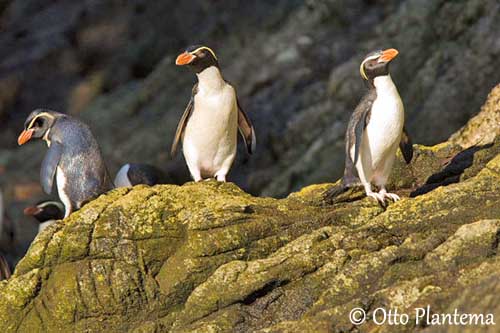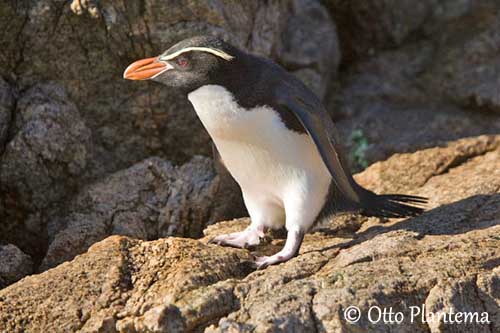
Fr: Gorfou des Snares
All: Snaresinselpinguin
Esp: Pingüino de las Snares
Ital: Eudipte dell'Isola Snares
Nd: Snareskuifpinguïn
Sd: Snaretofspingvin
Photographer:
Otto Plantema
Trips around the world
Text by Nicole Bouglouan
Sources:
HANDBOOK OF THE BIRDS OF THE WORLD vol 1 by Josep del Hoyo-Andrew Elliot-Jordi Sargatal - Lynx Edicions - ISBN: 8487334105
BirdLife International (BirdLife International)
Penguins of the world (Mike Bingham)
PENGUINWORLD (Lloyd Spencer Davis)
PhotoVolcanica - Photography and Information by Dr Richard Roscoe
ANIMALS – Explore, discover, connect
Snares Penguin
Eudyptes robustus
Sphenisciforme Order – Spheniscidae Family
INTRODUCTION:
The Snares Penguin breeds on the small Snares Islands. They are today a marine sanctuary off the southern coast of South Island in New Zealand.
It nests in dense colonies, but it has restricted range and breeding areas and the species is evaluated as Vulnerable.
It is also called Snares-crested Penguin and Snares Island Penguin.
DESCRIPTION OF THE BIRD:
Biometrics:
Length: 55-73 cm
Weight: 2800-3400 g
The adult has dark slate-grey upperparts and white underparts. The head is blacker. We can see a pale yellow stripe running from the bill base and over the eye, and ending in a bushy crest formed by drooping feathers on the sides of the hindcrown. Chin and throat are black too.
The thick bill is brownish-red, with pale pink bare skin around the base. The eyes are deep red. Legs and webbed feet are pale pink with black claws.

Both sexes are similar, with the male larger than the female and with thicker bill.
The juvenile has thinner and shorter yellow crest, white throat with black spots and brownish bill.
The chick is covered with thick down, dark brown above and whitish below. The second down is similar but pure white on the underparts.
RANGE:
The Snares Penguin is endemic to The Snares, S of South Island in New Zealand, a group of small islands or rocks.
HABITAT:
The Snares Penguin is marine, and pelagic outside the breeding season. These islands are formed by steep cliffs on the coasts and dense vegetation at top. This penguin nests on rocky slopes or in muddy forested areas.
CALLS AND SONGS: SOUNDS BY XENO-CANTO
The Snares Penguin has a wide range of vocalizations, a variety of sounds such as hissing, cries and sometimes trumpeting. These calls are far-carrying and can be heard over great distance. The contact call is a sharp barking sound. A short growl is produced in aggression. Mates utter quiet humming sounds. They are noisy but very social.
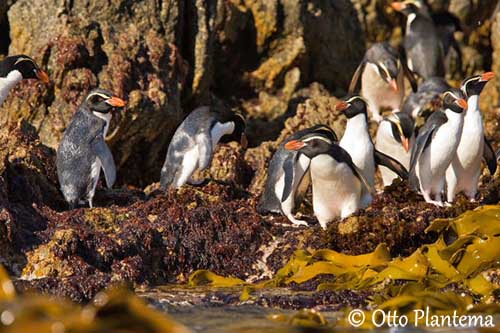
BEHAVIOUR IN THE WILD:
The Snares Penguin feeds primarily on krill and crustaceans of genus Euphausia and Nyctiphanes australis. It also takes cephalopods and some fish. They often fish in small groups and capture the preys by shallow pursuit-diving. It often eats more than it needs to build up fat. Preys are swallowed whole.
The male dives down to 55-120 metres whereas the female may reach only 19-20 metres depth, avoiding competition for preys, especially during the nesting period. They usually remain over the continental shelf to the NE of the islands.
The Snares Penguin can be aggressive and territorial, and some fights may occur but nothing very strong. They may use their bill to push at each other. This behaviour helps to establish the order of the hierarchy within the group.
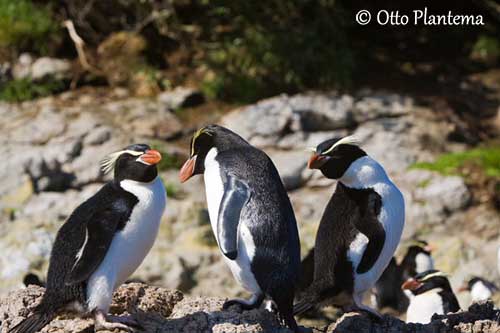
During the breeding season some displays are observed. The paired birds have long-term pair-bonds, and have high fidelity to the nest-site. As usual, the male arrives first and the female a week later.
The male displays to attract the female. It stands up with fully extended flippers. If she is attracted, she stays close to the male which bows. And she bows too. They continue these displays in order to strengthen the pair-bonds.
The Snares Penguin is dispersive and moves mainly to find food. For that, it may migrate as far as it needs. They are often observed along the coasts of Stewart Island, Australia and Chatham Island, and are sometimes seen around Tasmania.
Like all penguins, it swims and dives very well, thanks to the flippers which propel the penguin through the water and at good speed.
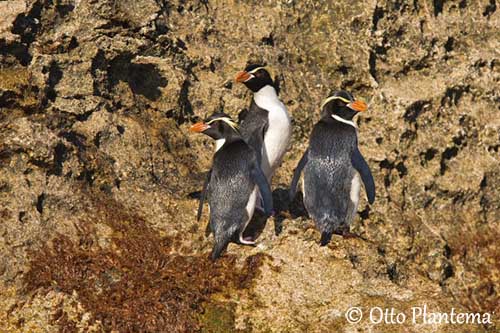
REPRODUCTION OF THIS SPECIES:
The Snares Penguin arrives at the colony in August-September and the laying starts in September-October.
The colonies can contain several hundreds pairs. Both adults build the nest, but the male does most of the work. They nest in the areas around trees in forest or on the coastal rocks. The nest is a shallow depression dug in the ground. Layers of various materials such as pebbles, grass, leaves and twigs can complete this structure. There is sometimes a rim around the nest, made with mud. The nest is usually under trees or bushes to avoid the direct sunlight.
The female lays two eggs, and both parents take turns of 5-25 days during the incubation which lasts 31 to 37 days. Usually, only the second egg, larger than the first one, will hatch. The other chick rarely survives.
Both adults take turns to guard the chick while an adult, often the female, goes at sea for food. At 20 days old, the young joins a crèche. It fledges at 11 weeks and is able to go into the water. It is sexually mature at six years, but they usually start mating between 5 and 9 years old.
PROTECTION / THREATS / STATUS:
The Snares Penguin is preyed upon by Hookers Sea Lions (Phocarctos hookeri) and Leopard Seals Hydrurga leptonyx), whereas eggs and chicks are taken by skuas and petrels of genus Macronectes which attack on rocks near the coast.
The Snares Penguin is Vulnerable due to its restricted range and breeding grounds, and it depends on food availability. The main threats are commercial fisheries which reduce the numbers of preys, climate changes and oil pollution.
However, The Snares are nature reserves and marine sanctuary where the penguins are protected from human disturbance. There are approximately 30, 000 pairs of this species.
